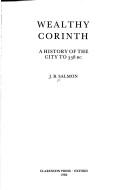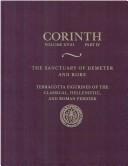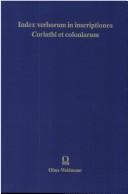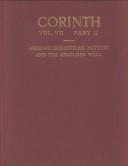| Listing 1 - 10 of 45 | << page >> |
Sort by
|
Book
ISBN: 1621390233 9781621390237 9780876616611 0876616619 Year: 2022 Publisher: Princeton, New Jersey: American School of Classical Studies at Athens,
Abstract | Keywords | Export | Availability | Bookmark
 Loading...
Loading...Choose an application
- Reference Manager
- EndNote
- RefWorks (Direct export to RefWorks)
Corinth (Greece) --- Greece --- Corinth, Greece --- Kórinthos (Greece) --- Corinto (Greece) --- Corinthe (Greece) --- Antiquities. --- History --- Architecture, Greek

ISBN: 019814833X Year: 1984 Publisher: Oxford Clarendon
Abstract | Keywords | Export | Availability | Bookmark
 Loading...
Loading...Choose an application
- Reference Manager
- EndNote
- RefWorks (Direct export to RefWorks)
Corinth (Greece) --- Corinth, Greece --- Kórinthos (Greece) --- Corinto (Greece) --- Corinthe (Greece) --- History. --- Corinthe (Grèce) --- History --- Histoire

ISBN: 0876610750 Year: 2001 Publisher: Princeton (N.J.): American school of classical studies at Athens
Abstract | Keywords | Export | Availability | Bookmark
 Loading...
Loading...Choose an application
- Reference Manager
- EndNote
- RefWorks (Direct export to RefWorks)
Pottery, Greek --- -Greek pottery --- Classical antiquities --- Pottery, Classical --- Corinth (Greece) --- -Antiquities --- -Corinth (Greece) --- -Corinth, Greece --- Kórinthos (Greece) --- Corinto (Greece) --- Corinthe (Greece) --- Antiquities --- Greek pottery --- Corinth, Greece --- Antiquities.
Book
ISBN: 9783774935457 3774935459 Year: 2007 Volume: 10 Publisher: Bonn s.n.
Abstract | Keywords | Export | Availability | Bookmark
 Loading...
Loading...Choose an application
- Reference Manager
- EndNote
- RefWorks (Direct export to RefWorks)
Pottery, Roman --- Céramique romaine --- Pottery, Greek --- Greek pottery --- Classical antiquities --- Pottery, Classical --- Corinth (Greece) --- Corinth, Greece --- Kórinthos (Greece) --- Corinto (Greece) --- Corinthe (Greece) --- Antiquities.

ISBN: 3487093642 9783487093642 Year: 1990 Volume: 117 Publisher: Hildesheim : Olms-Weidmann,
Abstract | Keywords | Export | Availability | Bookmark
 Loading...
Loading...Choose an application
- Reference Manager
- EndNote
- RefWorks (Direct export to RefWorks)
Inscriptions, Greek --- Inscriptions grecques --- Indexes --- Index --- Catalogs. --- -Greek inscriptions --- Greek language --- Greek philology --- Catalogs --- Corinth (Greece) --- -Antiquities --- -Catalogs --- Greek inscriptions --- Corinth, Greece --- Kórinthos (Greece) --- Corinto (Greece) --- Corinthe (Greece) --- Antiquities --- Inscriptions, Greek - Greece - Corinth - Catalogs. --- Corinthe (Grèce) --- Grèce --- Antiquités

ISBN: 0876610726 9780876610725 Year: 1975 Volume: 7, pt. 2 Publisher: Princeton (N.J.): American school of classical studies at Athens
Abstract | Keywords | Export | Availability | Bookmark
 Loading...
Loading...Choose an application
- Reference Manager
- EndNote
- RefWorks (Direct export to RefWorks)
Vases, Greek --- Vases --- Corinth (Greece) --- Antiquities --- -Vases, Greek --- -Greek vases --- Containers --- Urns --- -Antiquities --- -Corinth (Greece) --- -Corinth, Greece --- Kórinthos (Greece) --- Corinto (Greece) --- Corinthe (Greece) --- Greek vases --- Corinth, Greece --- Antiquities. --- Vases, Greek - Greece - Corinth --- Vases - Greece - Corinth --- Corinth (Greece) - Antiquities
Book
ISBN: 9781784538231 178453823X 9781786723581 9781786733580 Year: 2018 Publisher: London I.B. Tauris
Abstract | Keywords | Export | Availability | Bookmark
 Loading...
Loading...Choose an application
- Reference Manager
- EndNote
- RefWorks (Direct export to RefWorks)
"Late antique Corinth was on the front line of the radical political, economic and religious transformations that swept across the Mediterranean world from the second to sixth centuries CE. A strategic merchant city, it became a hugely important metropolis in Roman Greece and, later, a key focal point for early Christianity. In late antiquity, Corinthians recognised new Christian authorities; adopted novel rites of civic celebration and decoration; and destroyed, rebuilt and added to the city's ancient landscape and monuments. Drawing on evidence from ancient literary sources, extensive archaeological excavations and historical records, Amelia Brown here surveys this period of urban transformation, from the old Agora and temples to new churches and fortifications. Influenced by the methodological advances of urban studies, Brown demonstrates the many ways Corinthians responded to internal and external pressures by building, demolishing and repurposing urban public space, thus transforming Corinthian society, civic identity and urban infrastructure. In a departure from isolated textual and archaeological studies, she connects this process to broader changes in metropolitan life, contributing to the present understanding of urban experience in the late antique Mediterranean"--
292.1 --- 292.1 Godsdiensten van de Grieken --- Godsdiensten van de Grieken --- Corinth (Greece) --- Corinth, Greece --- Kórinthos (Greece) --- Corinto (Greece) --- Corinthe (Greece) --- History. --- Greece --- History --- 902:28 <38> --- 902:28 <38> Christelijke archeologie--Oud-Griekenland --- Christelijke archeologie--Oud-Griekenland
Book
ISBN: 9781107046375 9781107110168 9781107675254 9781139960045 1139960040 1107110165 9781139957922 1139957929 9781139958981 1139958984 1107046378 1139950479 9781139950473 1139962167 9781139962162 1322066361 9781322066363 1139961098 9781139961097 113994942X 113995685X 1107675251 Year: 2014 Volume: 159 Publisher: New York Cambridge University Press
Abstract | Keywords | Export | Availability | Bookmark
 Loading...
Loading...Choose an application
- Reference Manager
- EndNote
- RefWorks (Direct export to RefWorks)
This work re-examines the divisive wisdom that Paul addresses in 1 Corinthians. Challenging the recent consensus that the Corinthians' wisdom was rooted primarily in the Greco-Roman rhetorical tradition, Timothy A. Brookins offers a revisionary thesis centered on discourse similarities between the perspective of the Corinthian 'wise' and the Stoic system of thought. Brookins argues that several members of the church, after hearing Paul's initial gospel message, construed that message in terms of Stoic philosophy and began promoting a kind of 'Stoic-Christian' perspective that helped to precipitate divisions in the church. Being apprised of their views, Paul then exploited the 'Stoic' discourse of his opponents in order to sustain common discursive ground. In addition to providing a fresh synthesis of the data in 1 Corinthians, Brookins brings in cutting-edge research on the ancient economy as he explores questions related to philosophical education and social status within the church community.
Stoics. --- Bible --- Criticism, interpretation, etc --- Corinth (Greece) --- Economic conditions. --- 227.1*2 --- Brieven van Paulus aan de Corinthiërs --- 227.1*2 Brieven van Paulus aan de Corinthiërs --- Ethics --- Philosophy, Ancient --- Bible. --- 1 Corinthians (Book of the New Testament) --- First Corinthians (Book of the New Testament) --- Criticism, interpretation, etc. --- Corinth, Greece --- Kórinthos (Greece) --- Corinto (Greece) --- Corinthe (Greece) --- Corinth (Greece) - Economic conditions.
Book
ISBN: 9783110314090 3110314215 9783110314212 3110314096 Year: 2013 Volume: 12 Publisher: Boston
Abstract | Keywords | Export | Availability | Bookmark
 Loading...
Loading...Choose an application
- Reference Manager
- EndNote
- RefWorks (Direct export to RefWorks)
This book analyses the stylistic, iconographic and historical aspects of the Chigi vase, the famous Protocorinthian olpe dating back as early as ca. 650 BC. The vase is the masterpiece of the Chigi Painter, a skilful vase-painter who was acquainted as well with the big size Corinthian painting. The different themes, which run along the three main friezes, link each other in order to build up a true iconographic program: its key point is the distinction between the lower frieze for the ephebes' paideia and the two main friezes which show the Corinthian elites through their activities - either real or symbolic ones - and distinguishing attributes. Paris' judgment is meant as part of this iconographic program as it shows, through a mythical paradigm, a necessary step of the life, i.e. the wedding, as well as the risks that it involves. The socio-political interpretation of the iconographic program opens the historical question of which system could be implied, as the vase was painted in a critical moment of Corinthian history, i.e. in the period when Kypselos became tyrant and exiled the Bakchiads. Finally, on the background of Demaratus' tradition, the analysis investigates a possible scenario for the arrival of the Chigi olpe in the hands of an Etruscan prince of Veii, in whose tumulus it was found in 1882.
Vases, Ancient --- Art and society --- Vases antiques --- Art et société --- Corinth (Greece) --- Corinthe (Grèce) --- Civilization. --- Civilisation --- Art et société --- Corinthe (Grèce) --- Art --- Art and sociology --- Society and art --- Sociology and art --- Social aspects --- Macmillan Painter. --- Corinth, Greece --- Kórinthos (Greece) --- Corinto (Greece) --- Corinthe (Greece) --- Corinth. --- Olpe Chigi. --- iconography. --- vase painting.
Periodical
ISSN: 23290730 15587185 Year: 1929 Publisher: Cambridge, Mass. : Harvard University Press,
Abstract | Keywords | Export | Availability | Bookmark
 Loading...
Loading...Choose an application
- Reference Manager
- EndNote
- RefWorks (Direct export to RefWorks)
The ancient site of Corinth dominates the land corridor between central Greece and the Peloponnese and was occupied continuously from at least the 10th century B.C. Corinthians profited from their geographical position to take a leading part in Greek trade and colonization in the West, and the city later became the capital of Roman Greece. American excavations at the site began in 1896 and have continued almost without interruption to the present day. The first Corinth volume presenting "Results of Excavations Conducted by the American School of Classical Studies at Athens" appeared in 1929 and, as scholars complete their research, further titles continue to be published. Each volume covers a particular building or set of buildings, or class of material culture. The series includes studies of lamps, sculpture, coins, inscriptions, and pottery. Because most of these ancient finds can be dated stratigraphically, these typological catalogues are invaluable reference works for archaeologists around the Mediterranean. Volumes in the Corinth series appear irregularly, and their numbering is not necessarily consecutive but determined by the type of material being published, or the part of the site described. Each volume is peer-reviewed, edited, and produced to the highest standards.
Antiquities. --- Corinth (Greece) --- Greece --- Archaeological specimens --- Artefacts (Antiquities) --- Artifacts (Antiquities) --- Specimens, Archaeological --- Corinth, Greece --- Kórinthos (Greece) --- Corinto (Greece) --- Corinthe (Greece) --- Material culture --- Archaeology --- Kultura klasyczna --- Grecja --- Kultura klasyczna. --- Fouilles (Archéologie) --- Grecja. --- Corinthe (Grèce) --- Antiquités --- Fouilles (Archéologie) --- Corinthe (Grèce) --- Antiquités
| Listing 1 - 10 of 45 | << page >> |
Sort by
|

 Search
Search Feedback
Feedback About UniCat
About UniCat  Help
Help News
News